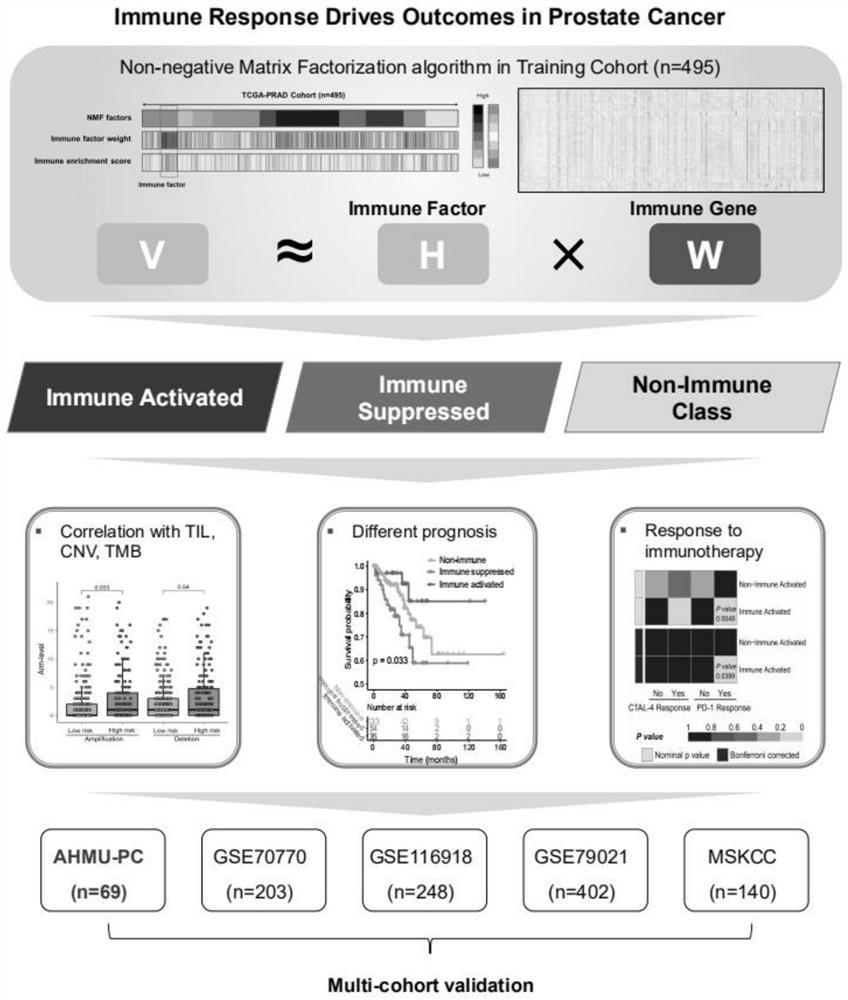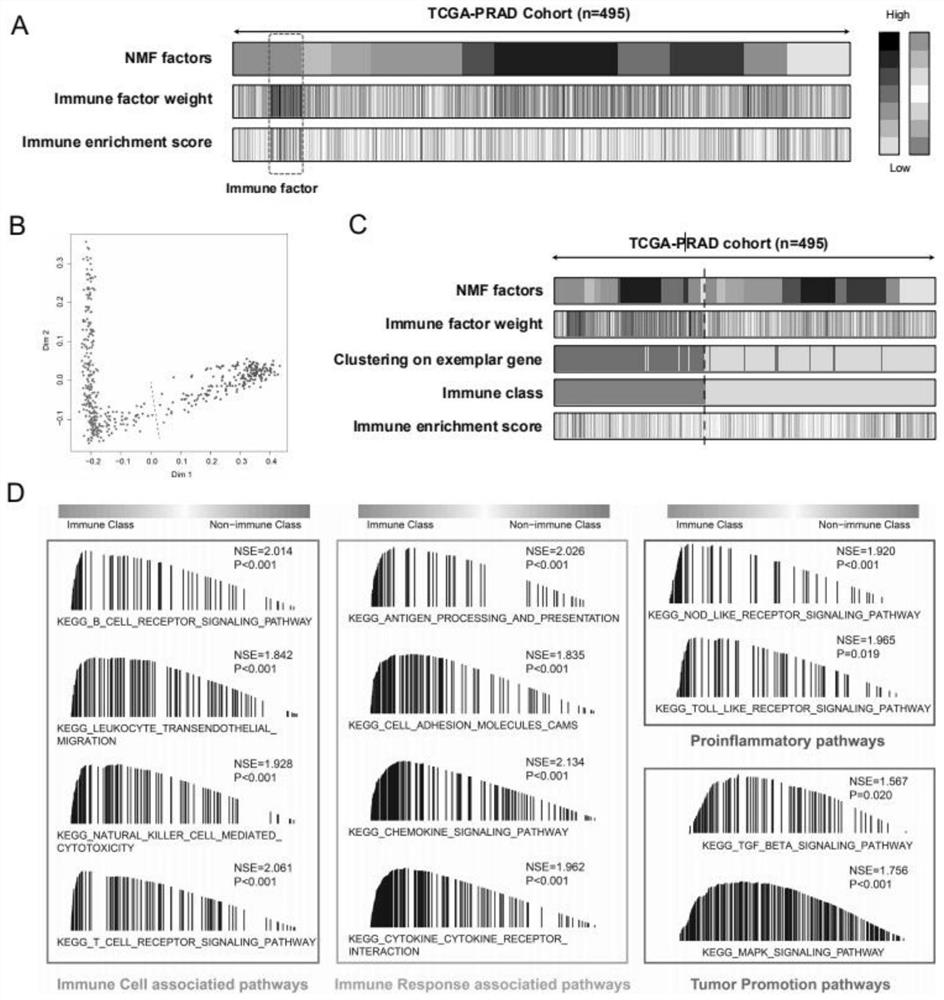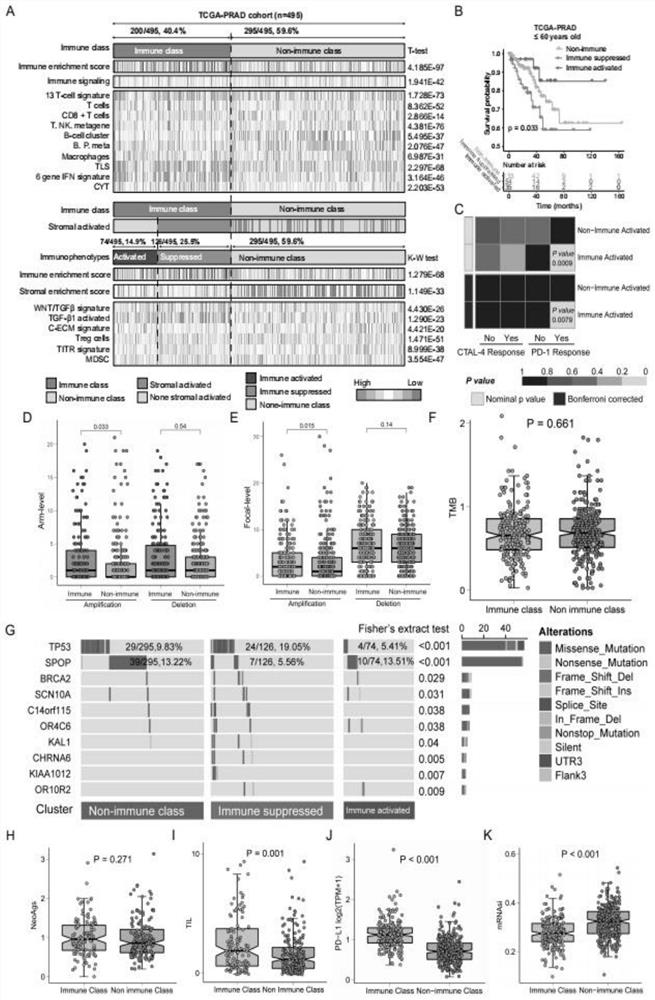Immune molecule classification system for prostate cancer patients and application thereof
A technology of prostate cancer and immune molecules, applied in the field of biomedicine
- Summary
- Abstract
- Description
- Claims
- Application Information
AI Technical Summary
Problems solved by technology
Method used
Image
Examples
Embodiment 1
[0025] Determination of immune subclasses:
[0026] 1. Patient collection:
[0027] ①A total of 1557 prostate cancer patients were included in the current study, whose information included available gene expression profiles, clinicopathological features, and recurrence-free survival records, and the research protocol flow was as follows: figure 1 shown;
[0028]② 495 patients from the Prostate Cancer Genome Atlas (TCGA-PRAD) were used as the training cohort, and three public cohorts from Memorial Sloan-Kettering Cancer Center (MSKCC), GSE70770, GSE116918 and GSE79021 were used as the validation cohort , a total of 993 prostate cancer patients were included in the study;
[0029] ③ The recurrence-free survival records of 69 formalin-fixed paraffin-embedded (FFPE) patients in the Urology Department of the First Affiliated Hospital of Anhui Medical University (AHMU-PC cohort) were collected;
[0030] ④ Based on the Illumina NovaSeq platform, the paired-end 150bp sequencing str...
Embodiment 2
[0051] Subtyping of immune subtypes established:
[0052] 1. Since the activated stromal response is negatively correlated with immune activation, 63.0% (126 / 200) of the patients with the immune subtype were characterized by high stromal enrichment scores (SESs) (such as image 3 A below picture);
[0053] 2. Transforming growth factor-β is considered a central mediator of immunosuppression in the immune microenvironment, while high levels of extracellular matrix cytokines (C-ECM) induced by activation of cancer-associated fibroblasts can recruit immune Inhibitory cells; as expected, Wnt / TGF-β, TGF-β1, and C-ECM signaling were found to be more active in the stromal-activated subtype, also known as the immunosuppressive subtype, than in the non-immune subtype (all P image 3 More enriched in A), the remaining 37.0% of patients (74 / 200) belonged to the immune activation subtype;
[0054] 3. Increased expression of IL-11, TGFB1, and TGFB2 in the immunosuppressive subtype compared...
Embodiment 3
[0060] Validation of the relationship between immune activation and good relapse-free survival and anti-PD-1 immunotherapy:
[0061] 1. Clinicopathological features are important indicators for evaluating the malignancy of prostate cancer. In the TCGA-PRAD cohort of patients under 60 years of age, relapse-free survival was better for the immune-activating subtype, lower for the immunosuppressive subtype, and intermediate for the non-immune subtype (P=0.033 ,like image 3 B);
[0062] 2. To test the potential ability of the immune molecular classification system in selecting candidates for anti-PD-1 / PD-L1 immunotherapy; the results showed that patients with immune activation subtypes responded better to anti-PD-1 immunotherapy (Bonferroni corrected P = 0.0079, as image 3 C).
[0063] In summary, combined with image 3 B-C, Patients in the immune activation category showed the best relapse-free survival outcomes and benefited more from anti-PD-1 / PD-L1 immunotherapy.
PUM
 Login to View More
Login to View More Abstract
Description
Claims
Application Information
 Login to View More
Login to View More - R&D
- Intellectual Property
- Life Sciences
- Materials
- Tech Scout
- Unparalleled Data Quality
- Higher Quality Content
- 60% Fewer Hallucinations
Browse by: Latest US Patents, China's latest patents, Technical Efficacy Thesaurus, Application Domain, Technology Topic, Popular Technical Reports.
© 2025 PatSnap. All rights reserved.Legal|Privacy policy|Modern Slavery Act Transparency Statement|Sitemap|About US| Contact US: help@patsnap.com



